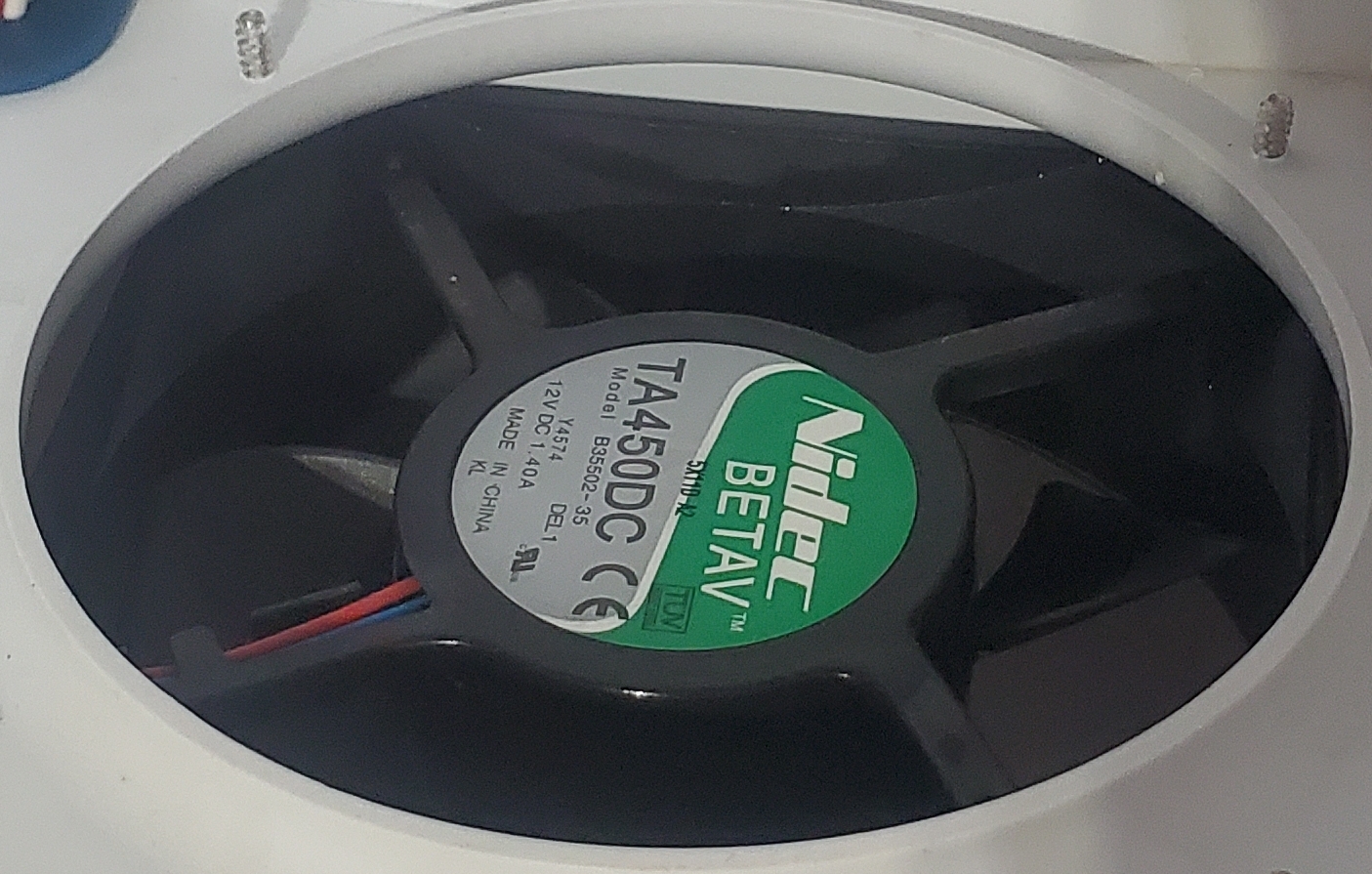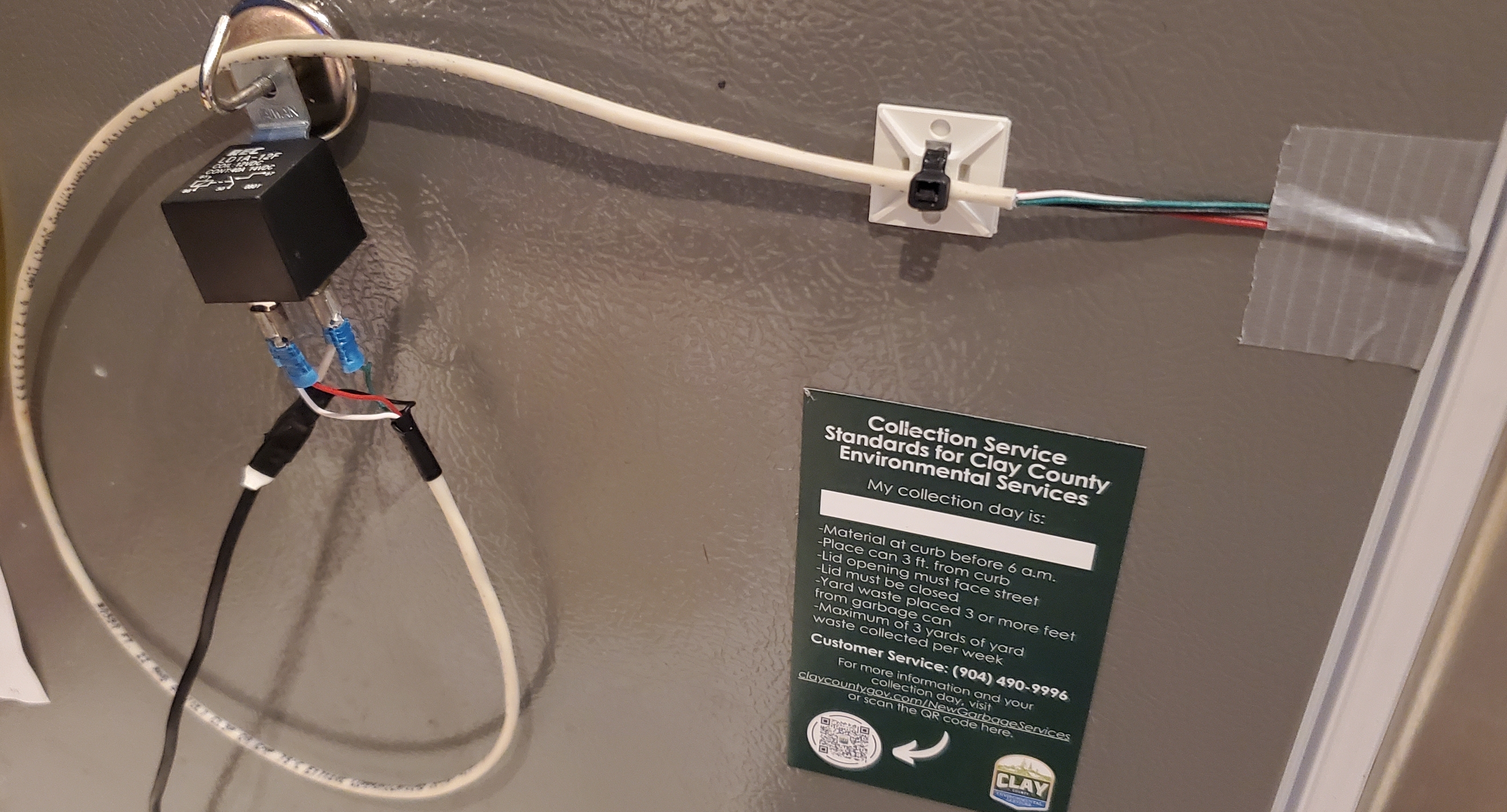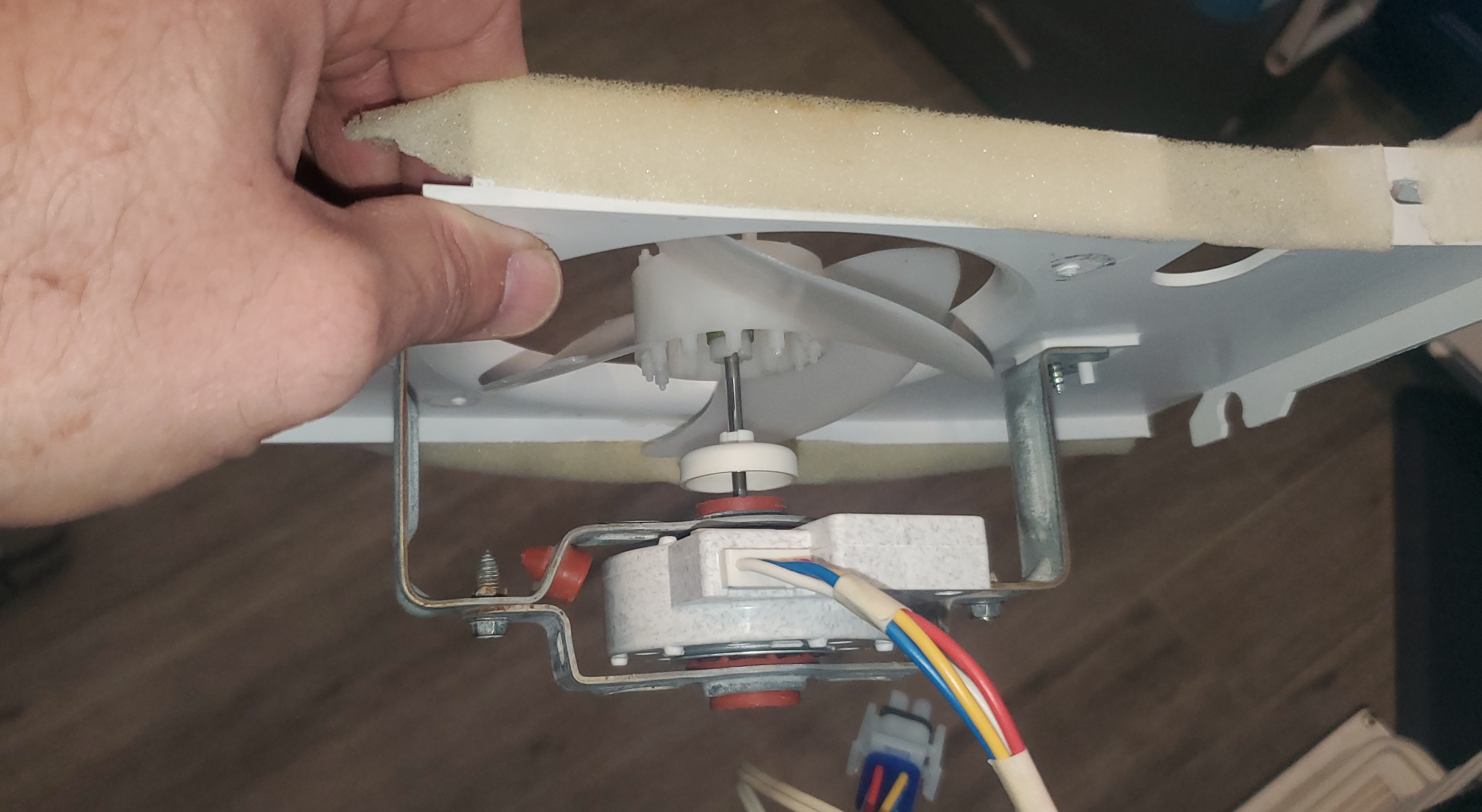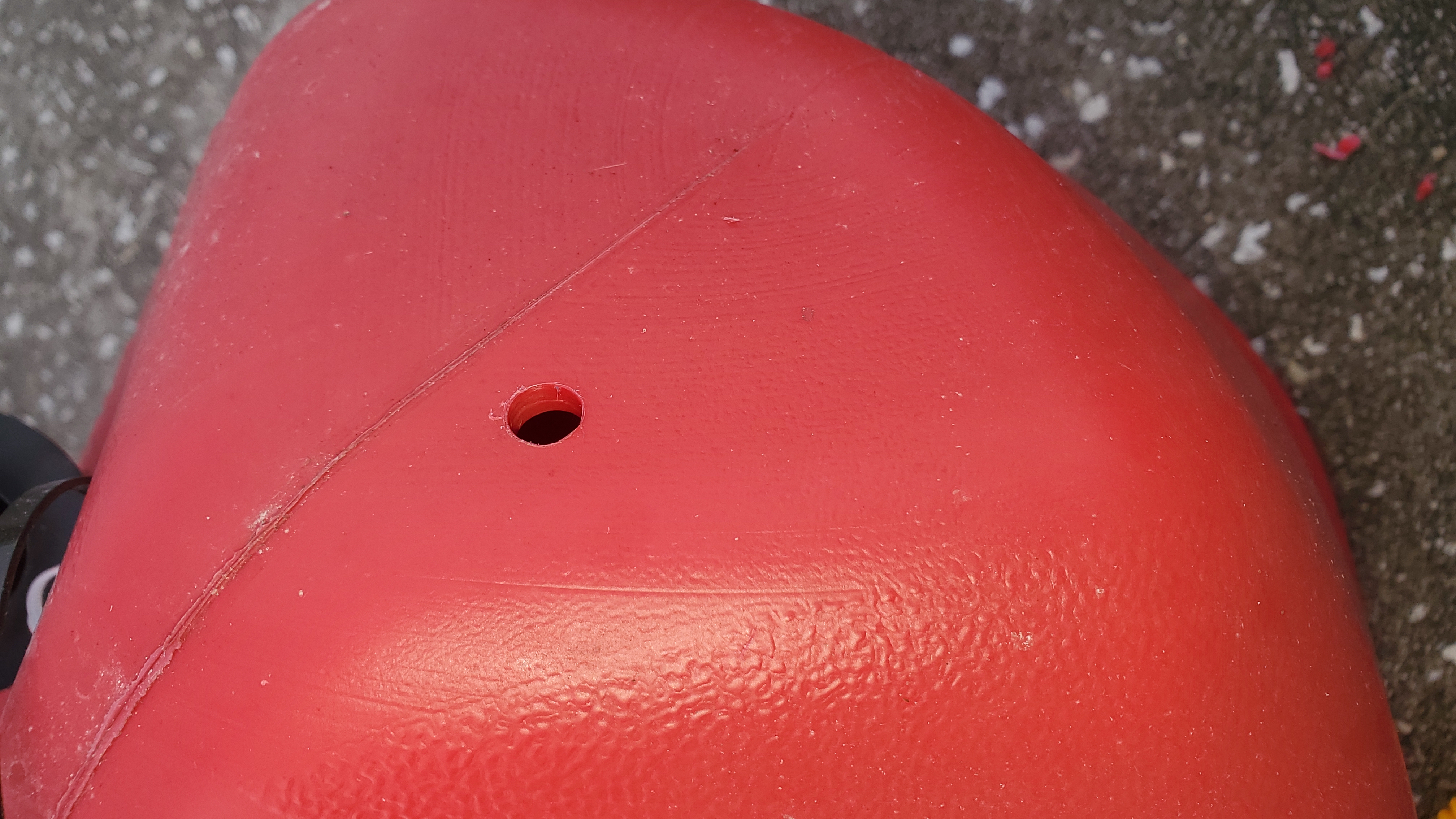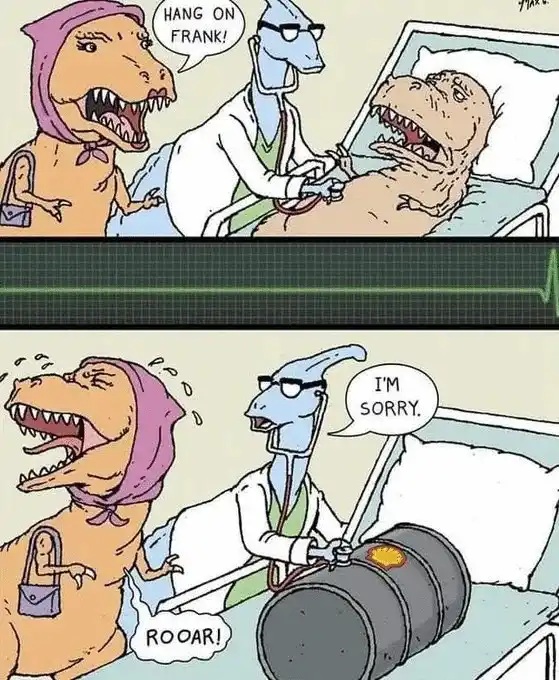Refrigerator Evaporator Fan Motor Hack
I woke up one morning, and began cooking breakfast so we could all go out for the day and get food for our Thanksgiving dinner. When I opened the freezer, I noticed that all of the ice was stuck together. The refrigerator compressor was running, but the evaporator fan wasn't running. It's an older GE fridge that was in the house when we moved in in 2011.
I have replaced the evaporator fan motor once before on this refrigerator. I found the motor in my Amazon order history, and got another one on the way. In the meantime, I need my fridge to keep working. So I decided to rig it with another fan motor for the time being.
The original fan has some weird voltage listed 9.75 Volts DC 3.25 Watts. They're variable speed motors, kind of like the 4-wire fan motors that they use for a CPU cooling fans.
I don't have anything like that laying around, but I do have a Nidec fan that came from the top of a computer server rack! It's 12V DC 1.4 Amps, it will move some serious air, also it's around the same diameter as the stock fan.
I pulled the evaporator fan housing out of the fridge, lined up the Nidec fan in the center of the air outlet, marked the housing and drilled 4 small holes to mount the Nidec fan. I used some rubber grommets between the fan housing and the fan, in the hopes that it would keep it from being too loud.
Here it is installed.
Now all that was left was some way to power the fan, and get it to run when the compressor was running. I figured that the original control circuit was still functional, so I wired the fan power to a 12V DC relay, then ran power from my power supply through that. I used some of those little magnets with hooks on them to route the wire and hang the relay.
But it didn't work. Apparently these variable speed fans have a tach signal that comes back to the fan's speed controller, again like with a CPU fan. If the controller doesn't get a tach signal back, it kills power to the fan. So my new fan started and ran for about 30 seconds, and would then shut right back off again.
However, I'm not one to give up so easily. I went to the next step and decided, I'll just use a 120V AC relay, and parallel the relay coil to the power for the compressor. Problem solved. In this picture you can also see the power supply I'm using. It's way overrated for the load, but that's OK because with switching power supplies they only use what you draw (with the exception of control circuitry) which is negligible.
To connect to the power wires for the compressor, I used those T-Tap connectors. They make some that have a female spade terminal built in. These are great, because you can use them without having to hack up the appliance's original wiring harness, and when you're finished you can just unplug the spade terminals and you're done.
I just used 22 gauge 6 conductor wire to power the fan, because it is small enough to allow for the door to still seal well. I just opened the jacket where it exited the fridge, so it was flat.
With everything in place, it was time to test it. Did it work? Oh yeah, it worked and the fan moved about the same amount of air as the factory fan!
The only downside was the noise. That Nidec fan is LOUD. Whenever I was on the phone with and I was in the kitchen, people would say, "Where are you? It sounds like you're in a server room." I had to let them know, it's just my refrigerator since I've rigged it.
Of course, I didn't want to leave it that way (insanely loud) so when the new fan arrived, I went ahead and put that one in.
Everything was looking good. But when I went to test it the fan would never start. Long story short, the main control board for the fridge was messed up. I looked online and found some information on the board. I don't have a schematic for the fridge, so I was looking for a video that might show a picture of one -- and I finally found one!
It might be hard to see, but there are four wires that go to the evaporator fan motor.
13V DC (Red)
Common/Negative (White)
Speed Control (Yellow)
Tach Signal (Blue)
The yellow wire is Yellow with a Black sripe at the control board, so I could test for voltage there (it changes from yellow/black to yellow at the fan connector). There was 13.2 volts there at the control board, but for some reason as soon as you put a load on it, it would drop to near zero. The power supply built into the control board was bad.
Now worries, I found that I could hotwire the OE fan. Worst case I would have to put the Nidec fan back in and rock that until I saved up for a new fridge.
To test the OE motor, I used a drill battery that is 12V DC. If I powered it with the red and white wires, then also put 12V DC on the yellow wire, the fan would take off at full speed. So that's what I did. I just ran two wires to the fan, negative and positive, and jumped the red and the yellow together. So now the OE fan motor will work, powered externally, with a relay to turn the fan on and off.
To make it look nice, I hung everything behind the fridge using those little magnet hooks. For now that's how I'm going to leave it, because everything else on the fridge works correctly. The temps read right, the automated airflow damper for the refrigerator side works, and the ice maker and water dispenser are all working fine.
Good times.
Please leave a comment, like it or hate it... You DO NOT need to register to leave a comment. Email addresses are NOT used. Just make one up "someone@somehost.com"
Make Gas Cans Great Again!
If you've used a newer gas can, say in the past five years or so, it's likely that it was a bad experience for you. I know it has been for me.
The newer gas cans have safety features that make them almost unusable. They are designed to be "safer" somehow, I'm just not sure how. Gas cans used to be a very simple thing. You popped off the cap, opened the vent, and poured gas out. It's gasoline -- everyone knows it's flammable, it smells, and you don't want to spill it if you can help it -- so you just don't.
However, like so many things, the government regulators decided that people needed to be "saved" from those dangerous gas cans.
That's where this story begins. I had to buy some newer gas cans, because the older ones I had were failing. One was starting to turn clear and began leaking, a few others were leaking at the mold lines (they're blow molded).
I looked around for new ones, and most stores I could find locally were carrying this Midwest gas can.
Sure, it looks pretty basic, but there's one issue -- unless you have three arms, you likely can't get the damn valve to work. You'll notice the red part half-way down the spout. That's the part that doesn't need to be there (I determined this immediately upon first use). With the gas can I retrofitted for this post, I already popped that part off with a screwdriver.
I have another gas can that uses some valve that has a green spring loaded flip part, then you can push a part forward, and open the valve. It's garbage because the seals are not made of Viton, or some other material that is gasoline resistant. As a result you can't open the valve because the O-rings are swollen.
Too much trouble for something so simple.
Someone on Substack mentioned that you can use the spouts for five-gallon water jugs as gas can spouts, however it wasn't known whether the threads for the cans were compatible.
I figured that someone might make a retrofit kit because that would be great! So, I decided to look on Amazon, and here's what I found.
This kit comes with five spouts, inserts for vents, caps for cans that already have vents, silicone rubber seals, two different lids course and fine thread (for spouts) and a drill bit to put vents in gas cans that don't already have vents.
Here's a view with the manual visible.
I decided to retrofit the first can I could find that was empty. It just so happened to be one of the Midwest gas cans. The other things that are held on by a zip-tie are the parts to seal the can with the spout inserted inside the opening for storage.
Here's another view before I retrofitted it, you can see the Midwest label for posterity.
Here is the gas can with all of the parts that I'm going to use.
Next was drilling the vent hole. I was surprised at how thick the gas can was at the top. I was not expecting it to be around 1/8 inch or around 2mm if you're a metric kind of person. I was careful to drill it slowly, so that I didn't get any plastic on the inside of the can.
The next step was to install the vent with the silicone seal.
I tried to push the vent plug in by hand but that wasn't happening. I ended up using a rubber mallet to drive it in.
Here's what it looks like when it's completed.
Here's a view from the top and back. You can see where I put the vent to the left. I did this because I didn't want it to be right where the seam was.
Now I have a new "old-style" gas can! As I deplete the other cans I'll retrofit them as well.
The kit was $18 after tax on Amazon. You can find tons of them with various different names. They are generic.
Hopefully this can help someone to keep rocking their gas cans longer. The spout is usually the part that rots first. Also, if you have to buy a new one, you can use one of these kits to make it suck less!
I don't think it's an accident that gas cans started to suck -- right around the same time they started to push electric lawn tools. But I'm sure it's just a coincidence. I'll have to run it by some of my "coincidence theorist" friends.
What do you think?
Please leave a comment, like it or hate it... You DO NOT need to register to leave a comment. Email addresses are NOT used. Just make one up "someone@somehost.com"
Oil: The Original Renewable Resource
This is an essay I did for my college English class on July 28, 2015. I hope you find it interesting.
============================================
Oil is first and foremost for many of the world’s economies. Oil, in some form or another, is a necessity required to sustain the global economy. Because of oil’s global demand; opinions of its use and extraction are constantly up for debate. With the combination of political and environmental literature on the subject; oil is most often shrouded in confusion. It’s hard to sort fact from fiction when it comes to the specifics about oil, its formation, production, and how much might be remaining in the world. Oil is naturally produced in ways that we don’t fully understand and found in places where it was assumed it wouldn’t be—we may never run out.
Much less is known about the natural formation of oil than most would expect. Because the process takes place over an extended period of time, there is still speculation as to exactly how oil is formed. Trask explains this well in his 1937 article “Where Does Oil Come From?”
Three things are necessary in order for an oil pool to form. First, there must be something present—source beds—to make the oil. Second, there must be some sort of container—reservoir—to hold the oil after it has been generated. Third there has to be a trap—structure—to prevent the oil from escaping, once it has been collected in the reservoir. (Trask 378)
Trask goes on to explain how oil almost always forms around areas where rivers deposit silt into the ocean, or around lagoons. When it comes to assuming the time for oil formation, opinions vary from a few thousand years, to over one million years. The science of oil formation is still not completely settled.
There are many methods by which oil is extracted. The vast majority of oil is pumped, but there are other ways to get petroleum up from the depths. In practice, the extent and properties of each reservoir (the “building blocks” of an oil field) are determined initially through the discovery well and subsequent appraisal wells, in addition to seismic results, which yield a range of values for porosity, permeability, volume, fluid saturations and other parameters (Pike 150). Drilling is necessary in the vast majority of oil discoveries because it’s very rare that oil finds its way to the surface under natural circumstances. The involvement of drilling drives the cost of oil discovery higher than one might expect. There is a lot of man hours and equipment required just to verify the existence of oil in a given area. Hydraulic fracturing, or Fracking, is another method by which oil is extracted from rock beds. Fracking is most often used in conjunction with horizontal drilling. Drilling at extreme angles makes breaking through tough rock nearly impossible. Hydraulic fracturing presents a method for breaking through the harder rock, allowing the oil or natural gas to rise so it can be extracted. Typically when the fracking fluid, usually water, is injected it is mixed with sand or aluminum oxide. These small granules hold the cracks open allowing the oil, or natural gas to escape. Fracking is a noisy and inefficient way to extract oil and natural gas, until more recently.
A well-driller, U.S. Well Services LLC, has developed cleaner technology to power fracking rigs. The company based in Houston, claims its patented Clean Fleet Technology, has already decreased emissions by 99 percent. significantly reduced noise pollution, and saved operational costs of $40,000 per day at sites in West Virgina. (Kosowatz 12)
U.S. Well Services LLC, has made simple improvements by using the natural gas extracted from the site to run turbine generators for power at the site. Previously fracking rigs used large diesel generators to power the equipment which was loud, and required massive amounts of fuel to be delivered to the site on a daily basis. Once oil is extracted it must be moved, or pumped from one place to another. Sometimes the oil is shipped by rail, but this is expensive and increases the risk of a massive oil spill. The best alternative is to ship the oil by pipeline, but sometimes there are drawbacks to this method, most notably political drawbacks. Take oil coming from the Caspian region for example. There are vast quantities of oil there, but getting it to port is quite a task. The most direct route to open sea and the one desired by the Caspian countries, is through Iran to the Persian Gulf. But the United States opposes that route because it would defy U.S. Sanctions against Iran and make Caspian oil hostage to political instability in the gulf (Cooper 690). Regardless of the extraction method, portability of product must always be considered.
There are many different types of oil and natural gas. Both oil and gas are divided into classes based on their chemical composition and composition of their source materials. In China there is concern about the types of natural gases that are available in some areas. The type of oil or gas available is important when cost of extraction is considered. Because different genetic types of shallow-buried gases have different accumulation processes, identifying the genetic types is significant for understanding the gas accumulation (Gao 347). The process by which oil is produced is called Catagenesis. Knowing at what point in the Catagenesis process the oil, gas, or coal is can greatly help in determining the quantity and quality of the substance to be extracted. In the quote below; OM refers to (Organic Matter).
Biochemical and physicochemical transformation of OM was accompanied by various (so far insufficiently studied) processes of its decomposition and synthesis. All these processes promoted the formation of diverse and intricate (in composition and structure) coals that are mined and utilized nowadays. Different combinations of paleogeographic and tectonic factors were responsible for the formation of giant coal basins and numerous different-scale deposits. (Korolev 515)
These technologies can be used to determine the type of substance and determine at what point in the process it is believed to be. Taking into consideration the types of oil, gas, and coal available, there are also concerns about the supply.
The world's supply of "conventional" oil -- oil that is easily recovered -- is running short of demand. In little more than a decade, some experts predict, global demand will so far exceed supplies of conventional oil that price shocks will occur that may lead to recession or political turmoil. (Cooper 685)
Of course this is in stark contrast to how another researcher sees this issue. Richard Pike, the former Chief Executive of the Royal Society of Chemistry in the UK, has a much different view. Oil reserves are calculated based on the minimum probability for extraction or P90. This is mostly because of market forces. Investors feel safer when they are going after “proven” reserves. Pike illustrates the error.
Consolidating to the company level is almost always arithmetical, and this is considered acceptable by the financial markets because its principal purpose is to provide a conservative estimate for reserves, that gives investors a high degree of confidence of being recovered. This form of aggregation continues to the country and world level. This is equivalent to assuming that the outcome, simultaneously, of every field in the world will be its “downside”, with no scope for “upside” beyond the P90 threshold. (Pike 2)
Interestingly, Pike uses dice as an example on how the method used to calculate oil reserves is fundamentally flawed. For this example the 1 on the die represents the P90 threshold for oil reserves. He explains that, with one die, the probability of rolling a number higher than 1 is 5 out of 6. When you have more dice in the picture, the odds are largely in your favor of rolling much higher numbers. Of course it is possible that you could roll 1 on all of the dice, but that is an extremely low probability. The chances are much greater that you will end up with considerably higher numbers.
Still if there is an issue with supply, there are artificial methods for producing oil. While these methods are in their infancy, some of them show great hope for solving at least some of the oil supply problem if that ever becomes a reality. Oil has been produced using algae in just a very short period of time; however, research into yeast as an oil producing organic option shows even more promise.
Microorganisms that could accumulate lipids at more than 20% of their biomass were named as oleaginous species [1]. Some yeast strains, such as Lipomyces sp., Rhodosporidium sp., and Rhodotorula sp. could accumulate intracellular lipids as high as 70% of dry weight of their biomass [2, 3]. The majority of those lipids were triacylglycerides with long-chain fatty acids that were comparable to conventional vegetable oils [4]. Microbial lipids have been recently considered as potential feedstock for the production of biodiesel [5–8]. Our early work demonstrated that oleaginous yeast Rhodosporidium toruloides Y4 produced notable quantity of intracellular lipid when cultivated in nitrogen-limited media with glucose as the sole substrate [9]. (Zhou 119-120)
This is amazing because it means that with only water and glucose the yeast were able to generate considerable energy from the fats that they accumulate. This is also notable because even though glucose would most likely come from some type of crop, it doesn’t have to be a crop that requires large amounts of energy to harvest. That was the largest problem for alcohol as a petroleum based fuel alternative. Alcohol is a terrible competitor to oil, coal, or natural gas because it requires more energy to produce it than you get when you burn the alcohol.
While some are worried about running out of oil, some are worried that we will destroy the planet by using too much oil. Futurist Brenda Cooper seems to think that we are going to “outrun” climate change by using technologies that exist today, while simultaneously creating new technologies.
Geospatial mapping, assisted by satellites and manned or unmanned aircraft, now enables us to compile detailed information on any spot on Earth and record indicators of its soil, animal life, and flora. This technology’s ongoing advancement will make it continuously easier to identify troubled areas and monitor efforts at protecting and restoring them. (Docksai 49)
There is similar thinking when it comes to oil consumption. While most forecasts are based on a never decreasing demand for oil, the opposite might be true. China for example has began a large move towards more fuel efficient vehicles.
Beijing has little strategic interest in emulating America's addiction to foreign oil. Accordingly, it has pushed consumers toward smaller engines via tax breaks. This is easier to do in an embryonic market where, unlike America, drivers don't feel like they are trading down to less powerful models. (Denning)
The move to become less dependent on oil, foreign or domestic is largely driven by the cost. Oil trades on the global market by way of many different currencies; however, oil is nearly always traded in U.S. dollars. While this is a great thing for the U.S. it poses quite an issue for some countries. There are embedded costs when having to trade in different currencies. Exchange rates are always changing, so it’s dangerous to trade out of one currency to another that might decrease in worth right after the trade “. . . .in 1972 and 1973 OPEC signed two agreements, known as Geneva I and Geneva II, which attempted to price oil in a basket of currencies. The agreements aimed to protect the price of oil against fluctuations in the value of the US dollar against other major currencies” (qtd. in Mileva 385). With more and more countries moving to decrease their dependence on oil – even China, there is a tipping point in oil usage vs. oil production. There is little doubt that oil, coal, and gas supplies are vastly greater than we know of at this point, couple that with the fact that demand is increasing at a non-linear rate; it’s reasonable to assume that we will never run out of oil. Also, one must consider the fact that even to this day oil is still shrouded in mystery. With such wide views as to how long it takes oil to form naturally; coupled with the fact that oil has been produced in labs in relatively short periods of time, nobody can say definitively that oil is not being produced naturally faster than we can use it. Oil has a strong possibility of becoming the first renewable resource.
Cooper, Mary H. “When will the world run out of oil?” Oil Production in the 21st Century.
8.29 (1998): 675-691. Print.
Denning, Liam. “China's Thirst for Oil Could Come Up Short” Wall Street Journal. 31 May.
2010. Web. 20 July. 2015.
Docksai, Rick. “Futurists Explore the Next Horizon.” The Futurist. 47.6 (2013): 47-52. Print.
Gao Yang, Jin Qiang, and Zhu Guangyou. “Genetic types and distribution of shallow-buried
natural gases” Petroleum Science. 7.3 (2010): 347-354. Print.
Korolev, Yu, and S. Gagarin. “Catagenesis of Humic Coals Inferred from the X-Ray Phase
Analysis and Mathematical Modeling.” Lithology and Mineral Resources. 40.5. (2005):
448-461. Print.
Kosowatz, John. “Hydraulic Fracturing's Greener Tint.” Mechanical Engineering-CIME.
137.6 (2015): 12. Print.
Mileva, Elitza, and Nikolaus Siegfried. “Oil market structure, network effects and the choice of
currency for oil invoicing.” Energy Policy. 44(2012): 385–394. Print.
Pike, Richard. “How much oil is really there? Making correct statistics bring reality to global
planning.” Significance. 5.4 (2008): 149-152. Print.
Trask, Parker D. “Where Does Oil Come From?” The Science News-Letter. 32.870. (1937): 378-
381. Print.
Zhou, Wenwen, Yonghong Li, Yongkui Zhang, Zongbao Zhao. “Energy efficiency evaluation of
lipid production by oleaginous yeast Rhodosporidium toruloides.” Journal of Thermal Analysis & Calorimetry. Vol. 108.1 (2012): 119-126. Print.
============================================
As it turns out, I might have been on to something. I’ve always questioned the “fossil fuel” argument ever since I was a child, simply because it sounds so corny.
Many years later, I decided to do a little research to see what I could find about how oil is formed. To my surprise -- there was very little information out there. Most of it centered on "what scientists believe" or "what most geologists believe." Nothing is very certain about any of it. On the other hand, you can look up all about the Moon's surface, and everything is stated as fact. I always thought that was a little strange.
Why would oil creation and the science around explaining it be so vague?
Because, I believe that Dr. Willie Soon is correct. "Willie Wei-Hock Soon is a Malaysian astrophysicist and aerospace engineer employed as a part-time externally funded researcher at the Solar and Stellar Physics Division of the Harvard–Smithsonian Center for Astrophysics."
He provides very reliable evidence that oil can be created through abiogenic processes.
Gas, oil and coal are commonly referred to as "fossil fuels". The term is based on the concept that all of these hydrocarbons where formed millions of years ago when prehistoric plants and animals died and were gradually buried by layers of rock. That is, they are supposedly all formed from the compression of biological "fossils" that became buried under ground for millions of years.
Dr. Soon was pointing out that there is considerable evidence that this is not the only way that hydrocarbons can be produced:
- For example, in a 2009 paper in Nature Geoscience, Kolesnikov and colleagues showed that under very high pressures and temperatures, methane gas can be converted into short-chained hydrocarbons https://doi.org/10.1038/ngeo591.
- Another example they discussed was the fact that liquid methane and small-chained hydrocarbons are found in Saturn's moon, Titan - see Mastrogiuseppe and colleagues (2019), Nature Astronomy; https://doi.org/10.1038/s41550-019-0714-2; Hayes (2016). Annual Review of Earth and Planetary Sciences. https://doi.org/10.1146/annurev-earth-060115-012247.
- Meanwhile, polycyclic aromatic hydrocarbons have also been found in Titan's atmosphere - see Zhao and colleagues (2018), Nature Astronomy, https://doi.org/10.1038/s41550-018-0585-y.
- They also mentioned that multiple chlorinated hydrocarbons have been identified on Mars by the Curiosity rover - see Freissinet and colleagues (2015), Journal of Geophysical Research: Planets, https://doi.org/10.1002/2014JE004737.
- Finally, several studies have suggested that PAHs (Polycyclic Aromatic Hydrocarbons) can also be formed in interstellar space (i.e., deep space in between stars). E.g., Dorian S. N. Parker and colleagues (2011), Proceedings of the National Academy of Sciences, https://doi.org/10.1073/pnas.1113827108.
But what does all of this mean?
From Dr. Soon's perspective, it means we should be careful not to assume all of the hydrocarbons on Earth are "fossil fuels". We do not yet know what percentage of the Earth's hydrocarbons were formed from biological fossils and what percentage were formed from non-biological ("abiogenic") processes.
However, it should be stressed that this does not necessarily mean that our accessible hydrocarbon reserves are limitless. As Dr. Soon pointed out the conditions Kolesnikov and colleagues (2009) showed could produce hydrocarbons abiogenically occur very deep underground - at least 50-100 miles. In contrast, the deepest oil or gas drill so far have only been 6 to 8 miles deep.
Dr. Soon also pointed out that current drills are not able to extract 100% of the oil and gas in the reserves - as the oil or gas is extracted, the pressure required to extract more becomes greater until it eventually becomes impractical to remove (with current technology, including fracking).
So, in terms of practical gas, oil and coal exploration, arguably it does not make much difference how the hydrocarbons in the known reserves were produced. Moreover, most coal, oil and gas companies spend considerable financial resources in the exploration of new reserves. This shows that from an economic perspective, the companies that are most heavily invested in the existing reserves are actively seeking new potential sites to drill.
On the other hand, as Dr. Soon later discussed, the widespread debates over "limited resources" and "renewable energies" are often non-scientific and unrealistic.
This gets back to the argument from Richard Pike. Pike believes that we will never run out of oil -- and it’s for that reason that we will destroy the climate/planet. Pike argues that we will continue to use oil excessively because it will always be available and cheap, unless governments take actions to make it more expensive. Of course that leads to the idea of carbon taxes, and other measures to make energy too expensive for common people to afford.
This is something that I wondered about as well. We don't know at what rate oil is produced. We don't know if oil is produced (in the aggregate) at a rate faster than we can extract it? There are a lot of questions.
Here is a link to the Tucker Carlson interview with Dr. Soon.
If you're wondering about Dr. Willie Soon, take a peek at his Wikipedia page. You'll see that he has been attacked and investigated, because people want to know who's funding his research. Interestingly almost none of the people investigating his funding are claiming that his research is flawed.
What do you think?
Please leave a comment, like it or hate it... You DO NOT need to register to leave a comment. Email addresses are NOT used. Just make one up "someone@somehost.com"
Has GMO Tech Already Gone Too Far?
Or, should we trust The Science™?
Many people have heard of GMO foods, but they are usually imagining things within the plant kingdom -- not the animal kingdom. Where has the trend in transgenic animals gone in the last decade or so? Let's take a look.
Milk resembling human breast milk has been produced by genetically engineered cows.
Chinese researchers announced in the journal PLoS ONE this week that they had engineered cows to secrete milk containing lysozyme, a protein found in human breastmilk that boosts the immunity of breastfed babies.
The researchers from the China Agricultural University and GeneProtein Biotechnology Company, both in Beijing, say alternatives to breastmilk are important because mothers are sometimes reluctant or unable to breastfeed.
"Modified bovine milk is a possible substitute for human milk," they wrote.
The researchers inserted human lysozyme genes into the nuclei of cells in the bodies of cows, and then used a technique called somatic cell nuclear transfer (the 'Dolly method') to clone the cows.
If it has the same effects in humans, Maga said, the milk could someday help ease malnourishment caused by diarrhea, which is a leading cause of infant mortality in some developing countries. The modified cow milk wouldn't be just for babies; conceivably any malnourished person, or person lacking in gut bacteria, could benefit from drinking it.
But before that happens, transgenic milk must move to the human testing phase. In the United States and Europe, genetically modified food gets a bad rap, and so human trials will probably be much slower to happen here than in China.
"Any transgenic animal product that goes on the market has to undergo extensive characterization beforehand. I'm sure in China they have a program to do that just like they do here," Maga said. But the difference is, China has a lot more resources and personnel working on it, as well as a completely different attitude toward genetic modification (GM), she explained. "In this country and in Europe there's a very loud anti-GM lobby, with advocates claiming that GM is unsafe."
Keith Schneider, a food scientist at the University of Florida who studies food safety, concurs. "With as much flak as we have in this country over GM, it will probably take much longer than three years to make it through (the testing stage) to the market," he said.
By contrast, Sky News in Beijing reported that a man, Jiang Yao, recently tasted the human/cow transgenic milk, and had this to say about it: "It's good. It's better for you because it's genetically modified."
Now that we've all been through the COVID Scare, things are no longer looked at the same way. Most of the public is now aware of the fact that Big Science has lied to them. The Science™ is no longer trusted because it has proven to be driven by motives that do not align with safety. In fact quite the opposite.
We know this because of numerous court cases filed against Pfizer which have been thrown out. It's not that Pfizer was not implicated in the production of dangerous products marketed as vaccines -- but because the US government expressly allowed for that in contracts.
In United States ex rel. McBride v. Halliburton, a 2017 decision by the U.S. Court of Appeals for the D.C. Circuit, and again in a 2018 decision from the 9th Circuit Court of Appeals, United States ex rel. Berg v. Honeywell Int’l, the courts dismissed fraud cases simply because the contractors in question cited “continuing government payments.”
And in 2018, the DOJ further diluted the False Claims Act via the issuance of the Granston Memo, which instructed government attorneys to reject more lawsuits filed under the Act.
In the two years which followed, dismissals of False Claims Act cases increased.
The newly proposed False Claims Amendments Act of 2021 would adjust the materiality standard to include instances where government payments have continued despite knowledge of fraud — this could affect Pfizer, which has contracts with the U.S. government to provide COVID vaccines.
But I'm sure that this milk is just fine. It might even be "safe and effective."
Scientists insist genetically modified foods are unlikely to pose a threat to food safety and in the United States consumers have been eating genetically modified foods for more decades.
However, during two experiments by the Chinese researchers, which resulted in 42 transgenic calves being born, just 26 of the animals survived after ten died shortly after birth, most with gastrointestinal disease, and a further six died within six months of birth.
Researchers accept that the cloning technology used in genetic modification can affect the development and survival of cloned animals, although the reason why is not well understood.
A spokesman for the Royal Society for the Protection of Animals said the organisation was "extremely concerned" about how the GM cows had been produced.
She said: "Offspring of cloned animals often suffer health and welfare problems, so this would be a grave concern.
"Why do we need this milk what is it giving us that we haven't already got."
Helen Wallace, director of biotechnology monitoring group GeneWatch UK, said: "We have major concerns about this research to genetically modify cows with human genes.
"There are major welfare issues with genetically modified animals as you get high numbers of still births.
"There is a question about whether milk from these cows is going to be safe from humans and it is really hard to tell that unless you do large clinical trials like you would a drug, so there will be uncertainty about whether it could be harmful to some people.
"Ethically there are issues about mass producing animals in this way."
Professor Keith Campbell, a biologist at the University of Nottingham works with transgenic animals, said: "Genetically modified animals and plants are not going to be harmful unless you deliberately put in a gene that is going to be poisonous. Why would anyone do that in a food?
"Genetically modified food, if done correctly, can provide huge benefit for consumers in terms of producing better products."
It's very easy to see why this hasn't gone as far as most people would have imagined. However, I don't think it's the ethical concerns that have so far stemmed the tide on the GMO cattle. The real reason is that creating these transgenic animals is complicated, and usually doesn't pan out so well. Most of the time there are only a handful of them that live to maturity, and they are unable to reproduce with other animals of the same species.
It would seem that the human antigen in cow's milk is the thing of the past. The Science™ is looking even further into the future this time. Now they're trying to produce cattle that have insulin in their milk.
"Mother Nature designed the mammary gland as a factory to make protein really, really efficiently," explained study leader Matt Wheeler, a professor of animal sciences at the University of Illinois Urbana-Champaign. "We can take advantage of that system to produce a protein that can help hundreds of millions of people worldwide."
...
"Our goal was to make proinsulin, purify it out to insulin and go from there," Wheeler said in a university news release. "But the cow basically processed it herself… The mammary gland is a magical thing."To produce the transgenic cow, a segment of human DNA was inserted into the cell nuclei of 10 cow embryos. It contained coding for proinsulin, a precursor of the active form of insulin. Through genetic engineering, the human DNA was targeted for expression in breast tissue only.
The altered embryos were then implanted in the uteri of normal cows in Brazil, and one transgenic calf was born.
Once she matured, researchers used artificial insemination to try to impregnate her. When that failed, they used hormones to stimulate her to produce milk for the first time.
Though she made less than a successful pregnancy would have produced, the milk not only had detectable levels of human proinsulin but also insulin itself. Researchers didn't expect that.
...
The next step is to re-clone the cow. Researchers are hopeful they will achieve greater success with pregnancy and full lactation cycles in the next generation of animals.Eventually, the goal is to create transgenic bulls, mate them with the transgenic females and create a "purpose-built" herd. Even a small herd could quickly outpace existing methods for insulin production — without any need for highly technical facilities or infrastructure, Wheeler said.
"I could see a future where a 100-head herd, equivalent to a small Illinois or Wisconsin dairy, could produce all the insulin needed for the country," he said. "And a larger herd? You could make the whole world's supply in a year."
While all of this sounds exciting to scientists, it's very creepy to most people. Who wants to drink GMO FrankenCow™ Milk? Milk that is "unlikely to pose a threat to food safety."
I know what is unlikely to pose a threat to food safety -- natural foods!
Has anyone wondered why there are so many diabetic people to begin with? Why is that not "the science" we're looking for? Wouldn't it better suit mankind as a whole to heal people -- and not just treat their symptoms?
What about those kids dying from malnourishment because of diarrhea? Why are there so many who are malnourished? And why would there be so many adults lacking in gut bacteria? Shouldn't these be things the science is looking for?
It's like they're looking for a workaround for everything -- instead of addressing the root of the problem. This is not good science, it's tampering with multiple genomes because economic and political situations are bad.
Correct the economic and political issues -- and stop trying to play Victor Frankenstein.
What do you think?
Please leave a comment, like it or hate it... You DO NOT need to register to leave a comment. Email addresses are NOT used. Just make one up "someone@somehost.com"
Malevolence and Punishment
Can you punish the "evil" out of someone? I don't know to tell you the truth -- but I'd be willing to bet the answer is NO. Can you sit someone in the corner until they decide to stop being evil? Likely not. Keep in mind that this essay is about hypotheticals.
Is it even possible to sufficiently punish someone, to the extent that they no longer want to commit malice towards others, or is it that you can scare them into submission, or perhaps they continue to get away with it -- until someone stops them? Once stopped, can they truly be reformed?
These are serious questions, because they determine how most people perceive the world around them.
Throughout history there have been evil people. But the level to which they are seen as "evil" varies based on the time period. For example, medieval torture practitioners were considered at the time to be "eccentric." We look at those acts now, and they are seen (rightfully so) as cruel and unusual.
Fast forward to today and things are quite different, in most of the world.
But there have been truly evil people running reeducation camps and torturing large numbers of people. In some parts of the world they still are, you just don't hear about it. Here in the US, the camps most hammered into people's minds are those run by Nazi Germany, but those were not the only reeducation camps. There were camps in many other countries that were specifically designed to break the spirit of the people contained within. Not to "reeducate" them, but to torture them until their very last breath. A sort of Hell on earth situation, run by the most sadistic people that could be found.
I think it's hard to argue that those who committed such acts are not evil. Similarly, I don't think a strong argument could be made that someone with the capacity to perform such acts could be "reformed."
A mental line is crossed when someone gets to that point. Perhaps they were always that way? Perhaps it was learned behavior. Many people who have come home from wars are haunted by the things they were capable of in such situations. Nobody can be sure how they will act in all situations. It's in those moments that people truly have to face their own being. That can be one of the most deeply moving, and deeply disturbing situations a person will ever encounter.
But back to the issue at hand. Can any of these kinds of human actions be avoided by the proper amount of punishment? Well, let me throw another curveball into this situation. Consider, what if the punishment makes the person (being punished) realize that they didn't commit their crimes in the "proper manner?" In other words, they are being punished because they didn't cover their tracks (well enough) -- not because what they were doing was wrong. I imagine that that is the situation the vast majority of the time, at least as it pertains to murderers.
Keep in mind that the majority of people who commit premeditated murder have already rationalized it in their minds. This is usually because the situation that drove them to the point of wanting to kill someone -- was outside of the bounds of law. Someone might have bullied them, or tormented them in a way that's technically "legal, but seriously messed up. Crimes can and are committed within the bounds of the law.
So what is any society to do? Well, there are limited options, and most of these issues have been fleshed out long ago. In fact, most people intrinsically understand this -- it's only in modern times that people have become so sheltered, as to believe that everything and everyone can be "healed." That's simply not the case. Not everyone can be afforded a second chance, nor do they want it.
Righteous indignation is not something that can easily be thwarted. People don't forget a perceived wrong -- not easily. And if that perceived wrong is "wrong enough" their perceived answer might be to put the perpetrator to death. We've seen this exemplified throughout history.
If everyone can be "healed" (their perceived wrongs corrected) why couldn't we end crime -- by capturing all of the criminals? Wouldn't there be a point where the last criminal is captured? Or, as I believe, some criminals are created spontaneously as various situations and opportunities present themselves.
Considering all of the above, what is the answer? The most obvious answers are containment, or death. After a horrific crime has been committed what other options are there?
How do you head off this possibility? I would imagine it would involve some form of "social engineering." Not the overt kind, but the kind that achieves largely positive outcomes by design. A system that rewards positive behavior as a result of participating in society. That is not to say that the laws should not punish bad behavior, but rather, laws should support and foster the methods and outcomes that result in people (whether knowing it or not) working on tasks that are beneficial to society.
However, this seems antithetical to what is expected in a free society. Social engineering to the level necessary get rid of all crime, would likely be tyrannical. As a result "right and wrong" would be highly subjective and often weighed against the overall outcomes of various people groups, and not based on individual outcomes.
A rights based system is the only way to achieve an approximate balance between right and wrong -- without moving into overtly tyrannical territory. God given rights can be clearly defined, and are far less subjective to opinion than what is right or wrong.
Or look at it this way, what system requires very specific behavior of its adherents -- to the point that they are ruled over to the extent that the outcomes are very predictable? Prison. That's the system that forces compliant behavior, a prison system.
Understanding that people are flawed is the philosophical basis for equally applied laws in a free society. People will never be perfected, as such, government and laws are necessary. And sometimes people have to be taken out of society -- because they will not follow the law. The law of course covers those who can not follow the law as well, those who lack mental capacity, or those who are insane.
Criminals, and the criminally insane will likely end up being removed from "voluntary society" and moved into some sort of prison, where societal norms are forced, not coerced.
The picture I used at the beginning of this essay is from one of the creepiest two Sci-Fi episodes I've ever seen. If you're unfamiliar with Doctor Who, you might be more interested after this particular episode S2 E18 and E19 (of the newer Doctor Who series).
Doctor Who is a time traveler, thousands of years old, and has pretty much seen it all, but in this episode even he is freaked out.
The entity he and his time travelling companion encounter is unlike anything he's dealt with before, and in fact might be the actual "Devil" as is referred to in many religious texts.
To the Doctor's question as to which Devil he is, given that there are so many religions, the Beast answers that he is all of them. He explains that the Disciples of the Light rose up against him leaving him defeated, and subsequently chained in the pit for all eternity. He states this occurred before the creation of this universe, to which the Doctor retorts that this is impossible as nothing could exist before the creation of the universe. The Beast asks the Doctor if that is his religion; a question that the Doctor can only answer with that is what he believes. The Beast tells the crew that they know nothing.
This begs the question, why was the Devil imprisoned by the Disciples of the Light and not reformed? Because sometimes people can't be reformed -- sometimes they are just evil.
What do you think?
Please leave a comment, like it or hate it... You DO NOT need to register to leave a comment. Email addresses are NOT used. Just make one up "someone@somehost.com"

